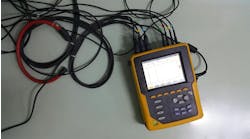Improving Power Factor with Variable Speed AC Drives
Utility power plant generators are usually designed for a power factor (PF) of .8 to .9. If demand-side PF is lower than the designed PF, the generator current will rise above the equipment's rated current or the active power output must be limited. As a result, these utilities put limits on reactive power consumed by their customers, who have to pay a penalty if their PF falls below certain limits, which can range from .8 to .97.
Electric motors connected to the power line are the main reason for reduced PF. The rated PF of a standard motor depends on its rated power and, typically, is around .85. However, it can be much lower if the motor is lightly loaded (Fig. 1).
Fig. 1. Graph of line current and power factor of a 55kW AC
induction motor as funtion of its load.
Before examining its effects on motors, a discussion of PF is in order.
The term power factor is often confused with cos φ (phi). PF is defined as the ratio of real or active power (P), expressed in total kilowatts, to total apparent power (S), expressed in kilovolt amps:
Fig. 2. The three basic linear electrical components
of this circuit connected in series with the voltage U,
are a resistor R, with resistance measured in ohms,
along with a corresponding voltage drop UR; an inductor,
with inductive impedance XL measured in ohms, and a
corresponding voltage drop UL; and a capacitor, with
capacitive impedance XC measured in ohms, and a
corresponding voltage drop UC.
In the electrical circuit shown in Fig. 2 above, the supply voltage connected to the circuit is at a single frequency. This voltage causes current to flow through the components. According to Ohm's Law, you calculate the voltage drop in each component by multiplying the current by the resistance. These voltages and currents can be expressed in phasor form (Fig. 3 below).
The current is common for each component in the system, but the voltages have different magnitudes, and their phasors are 90° apart from each other. The three diagrams in Fig. 3 show the steps for defining the voltage phasors and the angle between the total voltage and the current. This yields the definition for the cos φ:
To understand this concept, imagine a horse pulling a railroad car down a railroad track. Because the railroad ties are uneven, the horse must walk alongside the track. In doing so, it's pulling the railroad car at an angle to the direction of the car's travel. The power required to move the car down the track is the real power. The effort of the horse is the total, or apparent, power. Obviously, the car won't move sideways, so the sideways pull of the horse is wasted effort, or reactive power.
The benefits of VSDs
To produce the required rotating torque and speed, an induction motor takes both active current and reactive current from the power supply. The rotating torque of the motor is created as an interaction between the active current component and the magnetic field. The field is produced by the reactive current component. Light load takes less active current, but the magnetic field, as well as the reactive current, stays constant. This means that the power factor decreases with decreasing load. The current is mainly active at the full load but mainly reactive at the light load.
By installing variable speed AC drives, you can improve process controls, increase energy savings, and reduce wear on the machinery. Such drives also have the added benefit of improving PF.
The PF to the AC line on a pulse width modulated (PWM) drive with a diode bridge converter input is near unity (Fig. 4 below). The drive input consists of a rectifier bridge that converts the line AC voltage to DC voltage. The smoothing of the DC voltage is made via an inductor (L) and capacitor (C). The DC voltage (Ud) is then converted in the inverter to variable frequency and variable voltage AC that is connected to the AC motor. Switches V1 to V6 in the inverter are very fast semiconductors, usually insulated gate bipolar transistors (IGBTs) in modern drives.
Fig. 4. Schematic of a variable speed AC drive.
The output may have an inductive, or lagging, PF due to the motor's inductive reactance. However, the motor's reactive current is circulated between the motor and the inverter but not to the input line.
To better understand the process by which AC drives can improve PF, refer to the voltage level and motor and drive system in Fig. 1.
Motor mechanical power=55kW
Input voltage=400V, efficiency=94.4%, and power factor=0.89
Motor electrical input power=55kW÷0.944 = 58.3kW
Output power of drive=58.3kW, 94.5A
Input voltage=400V, efficiency=98% and power factor=0.96
Input power=58.3kW÷0.98=59.5kW
The formula for real power (P) in a 3-phase systems is as follows:
What does this mean in reduced losses and saved money?
The losses in the power line, transformers, and cables are proportional to the square of the current. You can estimate this as follows. Assume the average load on the 55kW motor is 35kW. From Fig. 1, the motor current at 35kW is 65A. The AC drive input current under these conditions is 60A.
The AC drive reduces the input current from 65A to 60A. The reduction of losses when operating the motor from an AC drive is described by the following equation:
If total losses on the supply side are 5% of the average load, the AC drive can reduce these losses to about 4%. Remember, the usual reason to install an AC drive isn't for PF improvement but for better process controls, energy savings in the process, and/or reduced wear of the machinery. PF improvement is a positive side effect.
Due to the fast switching inside the AC drive, there's a risk of electromagnetic emissions, which can take the form of conductive and radiating interference. International regulations set limits on both low- and high-frequency emissions. With the use of filters, screening, and suitable mechanical construction inside the drive cabinet, it's possible to meet the electromagnetic compatibility (EMC) standards.
PF comparison between AC and DC drives
The main difference between standard AC and DC drives is that PWM AC drives have a diode rectifier on the front end while DC drives have an SCR rectifier. The control principle of the SCR rectifier is based on phase control with line commutation, which causes a phase shift between voltage and current. The lower the speed, the larger the phase shifts. This reduces the PF of DC drives, especially in the lower speed ranges (Fig. 5).
Fig. 5. Power factor of AC and DC drives as function of motor speed.
PF is important to several parties in the power generation and consumption marketplace, including the following.
- Industrial, commercial, and domestic customers want to get the most cost effective electrical installation to serve their machinery. Low PF can mean extra losses and penalty payments to the utility for excessive reactive power.
- Power production and transmission companies would like to sell as much active power as possible to their customers. Low power factor can reduce the generating and transmission capacity.
- Manufacturers of power-factor-correction equipment are willing to sell capacitor banks and automation equipment to help improve the power factor.
- Consultants have an interest in helping power companies, consumers, and other interest groups with audits and plans for better energy economy and achieving higher power factors.
- Drive and motor manufacturers can also help to improve the power factor with variable speed drives. VSDs help solve the power factor problem, while improving process control, saving electrical energy, and reducing machinery wear.
Peltola is emeritus director of marketing for drives and motors, ABB Oy, Helsinki, Finland.




